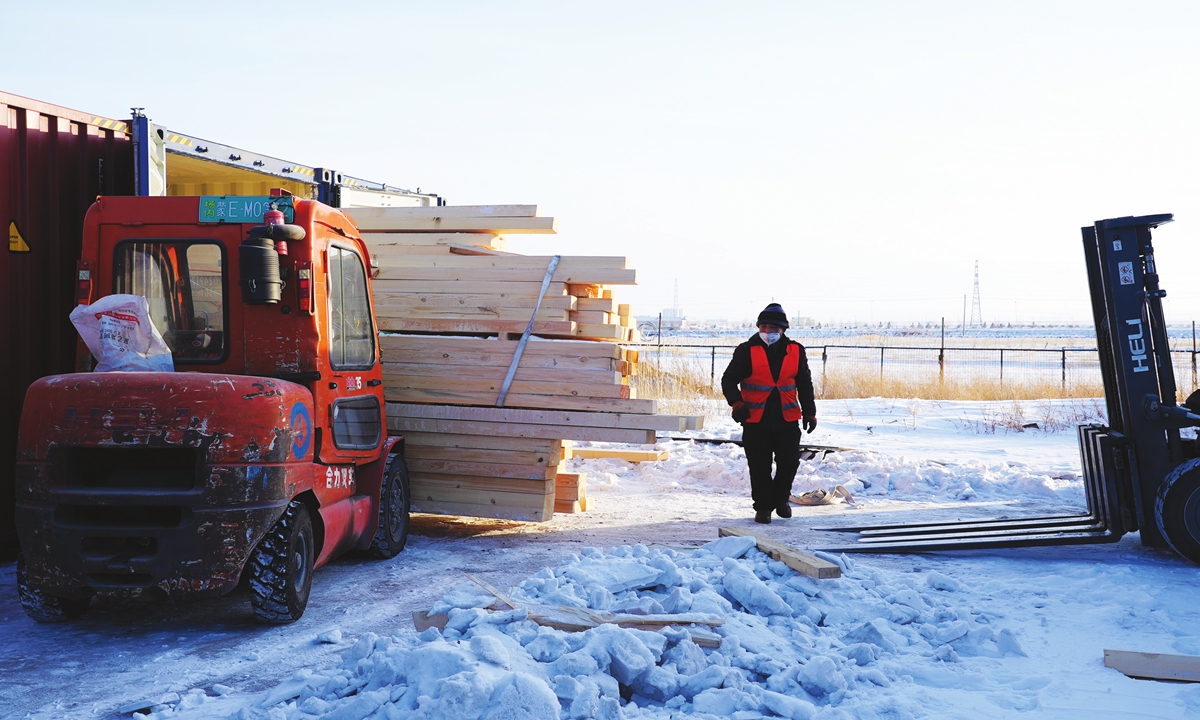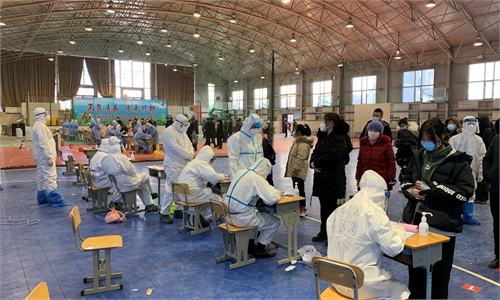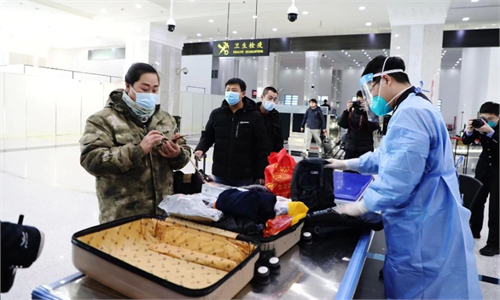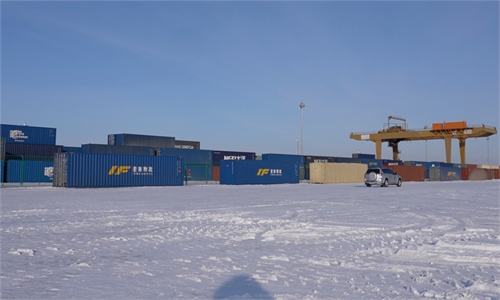As BRI enters 10th year of development, China-Europe freight train becomes the link of prosperity for cities on Eurasian landmass
A decade of fast growth alters boosts dynamics for Eurasian cities

A worker offloads imported wood from a container and waits for customs officers to inspect the consignment at a container yard at the Manzhouli port on February 9, 2023. Photo: Pang Yue/GT
Editor's Note:
This year marks the 10th anniversary of the China-proposed Belt and Road Initiative (BRI), a global cooperation platform that demonstrates China's vision and provides solutions to reform the global governance system and other multifaceted challenges. Reflecting on the development of the BRI over the last decade, there has been no shortage of evidence demonstrating that it is a big success, a momentum that relentless Western crackdowns and smears are unable to reverse.
Standing at this monumental juncture, the Global Times is publishing a series of articles to help readers understand the fruitful journey of the BRI over the last decade from multiple perspectives, and how the initiative will positively commence over the year. This is the third installment in the series, examining how the China-Europe freight train has boosted the dynamic of trade for dozens of cities on the Eurasian landmass.
Liu Hongjie, a manager with the North China division of Chinese logistics giant Sinotrans in Manzhouli, in North China's Inner Mongolia Autonomous Region, said she has been busy handling customs paperwork even during the week-long Spring Festival holidays, which end on January 27.
"My department has to prepare paperwork for three to five trains each day, and this means sometimes we have to work overtime, even during the holidays," Liu told the Global Times on Thursday, offering up details about the busy scene in the snow white city since China optimized its epidemic response in January.
"But to see train after train loaded with 'Made in China' goods heading toward Europe and train after train roaring back fully loaded with grain and timber is always a joy," Liu told the Global Times.
This year marks the 10th anniversary since the launch of the China-Europe freight train route in Manzhouli. Manzhouli is China's biggest land port that handles about 30 percent of all China-Europe freight train traffic, which stood at 16,000 units in 2022.
The truth is in numbers.
In 2013, there were just two trains departing from Erenhot, Inner Mongolia's second-largest land port and China's largest trade hub with Mongolia. Today, 43 trade routes covered by China-Europe freight trains connect over 50 domestic cities with over 40 localities and ports in nine countries including Russia, Finland, and Germany, according to media reports.
At Manzhouli, which lies at the geographic center of the Northeast Asia economic bloc the number of trains has exceeded 17,000 traversing 57 trade routes after a decade of development. Cargo trains leaving China from here now connect over 60 domestic cities with 28 foreign cities in 11 European countries in an evolving trade web.
The success of the China-Europe freight train service is a testament to how countries along the Eurasia route have worked toward common prosperity by reviving the old Silk Road through innovation.
Li Xin, director of the Institute for Eurasian Studies at the Shanghai University of Political Science and Law, told the Global Times on Thursday that cooperation on a China-Europe freight train route between China and Russia opened a new chapter in the development of the service.
China and Russia agreed to connect Russia's Trans-Eurasia railway with the Silk Road Economic Belt and the Maritime Silk Road at a top leaders' meeting in 2014 in Sochi, Russia, Li said, recalling the earliest days that saw the northern route of the China-Europe freight train route coming into existence.
Back then, the cooperation of freight train service also helped the two countries align the BRI and Eurasian Economic Union development strategy, Li said.
"With Russia onboard, the China-Europe freight train service naturally became a truly express route traversing the Eurasian landmass," Li said. "Currently, almost all the cargo leaving Eeast China's cities will go through the eastern route of the freight train services."
Bond among localities
Dozens of industrial cities on the landmass are connected with convenient door-to-door service.
In East China's Jiangsu Province, an economic powerhouse and manufacturing hub, the port city of Lianyungang was connected with cities in Mongolia via the cargo trains; provincial capital Nanjing and Xuzhou, a major city in the north of the province, found Russian cities at the end of the trade route and Suzhou, a hub of multinational manufacturing capacity, was linked with European cities via cargo trains.
Since 2021, Jiangsu has added a multimodal route between Suzhou and Helsinki, and the link that connects Xuzhou and Minsk, according to a statement by the Jiangsu International Freight Train Company sent to the Global Times on Thursday.
Because of the train, many lesser-known cities in China were able to transport their industrial products to European markets.
The hustle and bustle of the China-Europe freight train encapsulates Inner Mongolia's efforts to participate in the BRI and the China-Mongolia-Russia Economic Corridor.
For instance, in Inner Mongolia, Chifeng exported its drive axle and engines to Moscow and Wulanchabu exported its chemical products to Duisburg, Germany in two separate China-Europe freight train services in 2022.
After a decade of growth, Inner Mongolia's trade with Belt and Road markets now accounts for over 50 percent of its total foreign trade, customs authorities said.
"The freight train service served like a lifeline to prosperity, bonding China's plan of revitalizing the old industrial base in Northeast China and Russia's plan to develop its Far East," Li said.
It also fully tapped the advantage of Russia's century-old Siberia railway, which offered lower per-unit rates compared with China's, and the constantly increasing cargo volume will likely push Russia to complete its plans to upgrade the railway, according to Li.
Because of the introduction of new routes and the efforts by countries along the China-Europe freight train service route to vie for more cargo throughput, the overall cost has been reduced by about 10 percent over the last decade, Li said.
Boosting regional development
The cargo train service also contributed to the building of the China-Mongolia-Russia Economic Corridor, which has gained traction in recent years as highlighted by the three neighboring countries' push toward the bolstering of the Powerof the Siberia-2 pipeline, which will transport Russian gas to China via Mongolia.
Li said the trilateral economic cooperation, focuses mainly on major projects in energy supply and also includes the building of communication lines and digital infrastructure, will eventually attract more Chinese investment to Mongolia's mining and manufacturing industries, and result in a deeper level of industrialization of the country.
Construction of the Russian-Chinese natural gas pipeline transiting through Mongolia will begin in 2024, according to media reports.
With a decade of development, the China-Europe freight train service is becoming the new transportation artery of China, Europe and Central Asia, carving out new opportunities for cooperation and resulting in a win-win situation, Liang Haiming, Dean of Hainan University Belt and Road Research Institute, told the Global Times on Thursday.
Experts said, following the Russia-Ukraine conflict and the West's escalating sanctions against Russia, that Russia has become steadfast in pivoting toward the East and while there are also Japan and South Korea in this direction, the sheer size of trade volume between China and Russia has meant China will be the main actor.
For cities like Manzhouli and Erenhot, which are at the center of this upward trend, the growth potential is simply unlimited, Li said.




